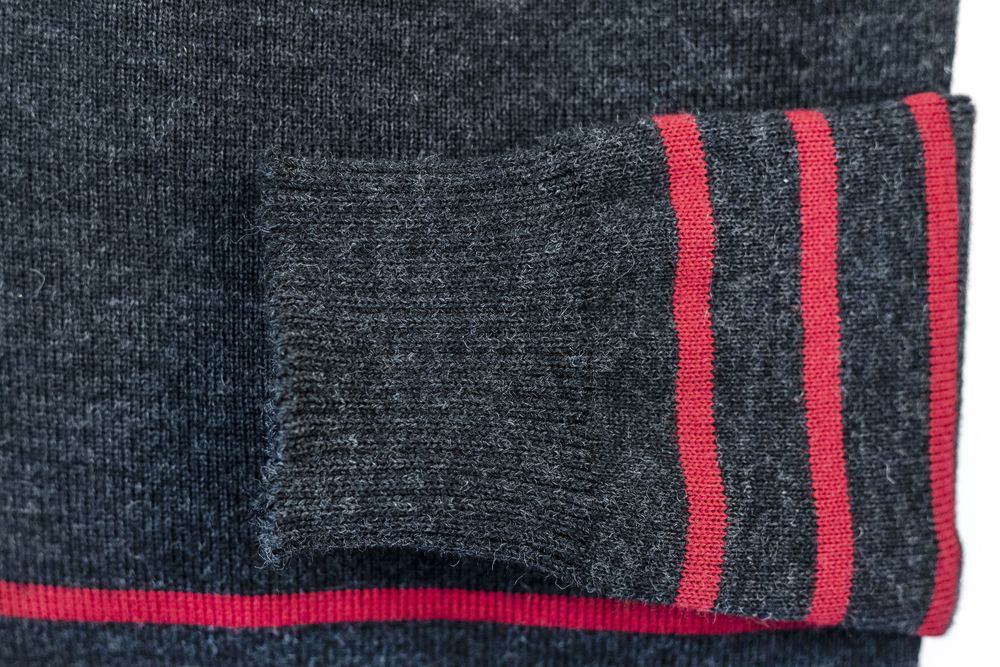1. The wool sweater: an essential in your wardrobe
Choosing a piece of clothing isn’t always easy, especially when it comes to a wardrobe staple like a wool sweater. We always worry that it’ll itch or be too big! It’s more than just a question of style or color. It’s about finding a quality piece that will keep you warm, is comfortable, looks great, and is durable.
The wool sweater is a timeless classic, loved for its warmth and versatility. Whether you’re at the office, strolling around town, or simply enjoying a quiet evening at home, a wool sweater is your best friend against the cold. But how do you distinguish a quality wool sweater from one that will start to pill or lose its shape after a few washes? In this article, we’ll walk you through the key elements to consider when choosing the right wool sweater.
2. The different types of wool
When it comes to sweaters, wool is a favorite choice for many. However, it is essential to understand that not all wool is the same. There are a variety of types of wool, each with its own unique characteristics and distinct benefits.
- Merino Wool : This wool comes from the Merino sheep, which is known for its extremely soft and fine wool. It is breathable, odor resistant and offers excellent thermal regulation. However, it requires special care when washing to avoid shrinkage.
- Alpaca Wool: Very soft and silky, it is also warmer and more durable than sheep's wool. It is less prone to pilling. On the other hand, it can be a little more expensive and some may find alpaca wool slightly irritating to the skin.
- Cashmere Wool: Coming from cashmere goats, this wool is incredibly soft and lightweight, while being exceptionally warm. It is considered a luxury wool. However, it is more expensive and can pill over time.
- Angora Wool: From the Angora rabbit, this wool is very soft, light and has a fluffy appearance. It is also very warm. On the other hand, it can cause allergies in some people and it is quite delicate to maintain.
- Mohair Wool: This wool comes from the Angora goat and is known for its shine and strength. It is warm and lightweight, but can be slightly irritating to the skin and a little more difficult to care for than other types of wool.
- Shetland Wool: Produced by Shetland sheep, this wool is warm and durable, ideal for chunky sweaters and wool knits. However, it is not as soft as other wools and can be a little rough to the touch.
- Lamb's Wool: This comes from lambs during their first shearing. It is extremely soft and fine. However, as it is rare, it can be more expensive.
- Camel Wool: Harvested from camels, this wool is very warm and durable. It has a distinct natural color. However, it can be harder to find and can be a bit rough compared to other types of wool.
For a more detailed exploration, we invite you to consult our article on the different types of wool here .
The advantages of wool over other materials
Of all the fibers available for clothing, wool clearly stands out for its distinctive natural benefits. This exceptional animal fiber is particularly appreciated for its thermal insulation. Able to retain heat when it is cold and to wick away sweat when it is hot, it ensures a natural regulation of body temperature. Thus, a wool sweater offers you adaptive protection against climatic variations, whether it is a harsh winter cold or a cool summer breeze.
Its robustness and natural elasticity are two other major assets. Wool garments stand the test of time, retaining their shape and appearance despite frequent use. They are designed to last, making your investment in a wool sweater truly profitable in the long run.
Wool is an environmentally friendly fiber. Biodegradable and renewable, it represents an ecological alternative to synthetic fibers derived from petroleum. Purchasing a wool sweater is therefore not only a choice of style and comfort, but also a conscious gesture in favor of the preservation of our planet.
Choosing the right wool sweater means first familiarizing yourself with the different characteristics of this unique material. It means carefully analyzing the product description before purchasing, checking the origin of the wool and carefully examining the quality of the knitting once the product is in hand.
3. How to recognize quality wool (density, feel, finishes, etc.).
When you hold a wool sweater in your hands, there are several aspects that can help you determine its quality. First, the density of the knit. A high-quality wool sweater will have a tight and regular knit, which guarantees better insulation and greater durability.
Next, the feel. Quality wool is soft to the touch, without any rough or scratchy feeling. If the sweater feels good next to your skin, that's a good sign.
Finally, the finish of the sweater can also reveal a lot about its quality. Examine the seams, which should be clean and regular, with no visible threads. The edges should be strong and well finished, ensuring that the sweater will keep its shape even after many washes.
The origin of the wool.
The quality of a wool sweater also depends largely on the origin of the wool used. Each type of wool has specific characteristics related to the breed of sheep it comes from. For example, merino wool is known for its softness and fineness, while alpaca wool is appreciated for its warmth and durability.
Additionally, the conditions in which the sheep are raised, the process of collecting the wool, and the spinning and dyeing techniques can all impact the final quality of the sweater. Therefore, opting for brands that provide detailed information about where their wool comes from is a sure way to choose a quality wool sweater.
4. Choose the right sweater style
- Crew Neck: Classic and versatile, the crew neck sweater suits most body types. It is ideal for a casual look and can be paired with casual or more formal outfits.
- V-neck: The V-neck sweater is a stylish and flattering choice, especially for those with larger busts. It elongates the neck and creates a more balanced silhouette.
- The sailor sweater: The sailor sweater is a timeless must-have, characterized by its round neck and horizontal stripes. It suits all body types and brings a touch of chic nautical style.
- The turtleneck sweater: Ideal for facing cold temperatures, the turtleneck sweater offers warmth and style. It is particularly recommended for people with a shorter neck.
- The Cardigan: The wool cardigan is versatile and easy to layer. It suits all body types and can be worn open or closed, offering a multitude of styling options.
- The trucker sweater: The trucker sweater, with its high collar and zipper, is ideal for a casual and sporty look. It suits all body types and adds a touch of robustness to your outfit.
- The Irish Sweater: The Irish sweater, recognizable by its intricate knitting and traditional patterns, is a rustic and warm choice. It suits all body types and adds a touch of authentic charm.

5. How to choose the right size of wool sweater.
Check the size guide: Carefully check the size guide provided by the brand or manufacturer. Each brand may have its own measurements and size standards, so it is important to check this information to ensure you choose the appropriate size.
- Take your measurements : Take your precise measurements using a measuring tape. Measure your chest circumference, waist circumference and sleeve length. Compare these measurements with the size guide to determine the size that fits you best.
- Consider the sweater style: Keep in mind that different sweater styles can have different fits. Some styles may be more fitted, while others may be looser. Think about your preference in terms of fit and desired silhouette.
- Consider layering: If you plan on layering your sweater with other clothing, such as a shirt or t-shirt, consider choosing a slightly larger size to allow for ease of movement and comfortable layering.
- Read reviews and feedback: If possible, read reviews and feedback from other customers regarding the sizing of the sweater in question. This can give you a better idea of the actual fit of the sweater and help you in your decision.
6. Care of the wool sweater
- Read the care instructions: Before cleaning your wool sweater, always check the care labels and instructions provided by the manufacturer. Follow these specific recommendations to avoid damaging the wool.
- Hand wash or delicate cycle: In most cases, it is best to wash your wool sweater by hand with lukewarm water and a mild detergent specially designed for wool. If you are using a washing machine, opt for a delicate cycle, 400 rpm at zero degrees.
- Avoid spinning and tumble drying: Do not wring your wool sweater to dry it. Instead, gently squeeze out excess water and lay it flat to dry on a clean towel. Also, avoid tumble drying your wool sweater, as this can cause shrinkage and deterioration in quality.
- Avoid direct ironing: Wool is a delicate fiber, so avoid ironing your sweater directly. If necessary, use a clean, damp cloth between the iron and the sweater to protect the wool.
- Store properly: When you are not wearing your wool sweater, fold it gently and store it in a dry, well-ventilated place. Avoid hanging it on a hanger, as this could cause deformation.
.jpg)
7. Take the weight of the sweater into account
When choosing a wool sweater, the weight of the fabric is a key factor to consider. The weight of the wool can affect the warmth, breathability, and comfort of the sweater. Here are some tips for choosing the right weight of wool:
- Consider the season and climate: For colder months, opt for a thicker wool sweater with a higher weight for better thermal insulation. For milder seasons, a lighter weight will be more appropriate for increased breathability.
- Assess your activity level: If you tend to be active and sweat easily, a lighter weight of wool may be better for better moisture management and faster drying. If you are more sedentary or looking for extra warmth, a heavier weight may be appropriate.
- Consider your style preference: The weight of the yarn can also influence the look of the sweater. A lighter weight will give a more fitted and versatile look, while a heavier weight will have a looser and more comfortable silhouette.
- Be aware of durability: Heavier wool sweaters may be more durable and long-lasting, while lighter wool sweaters may require a little more care and attention.
It is important to note that wool weight can vary depending on the brand and type of wool used. Be sure to review product descriptions and ask the manufacturer or seller questions for additional information about the specific weight of the wool sweater you are considering purchasing.
8. How to choose the right sweater?
- Understand the different types of wool and their unique properties to find the one that best suits your needs.
- Pay attention to the quality of the wool by evaluating the density, feel and finishes of the sweater.
- The origin of the wool is important, as this can influence its characteristics and durability.
- Choose the wool sweater style that best suits your body shape and personal aesthetic.
- Consider sizing to ensure you get a well-fitting wool sweater.
- Learn good care practices to preserve the quality of your wool sweater and extend its life.
- Finally, to find a wide selection of quality wool sweaters, we invite you to consult the Baie des Caps collection.

















